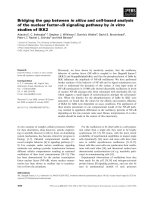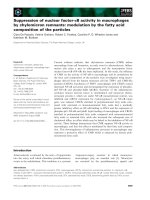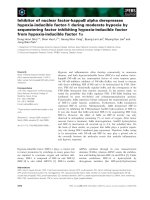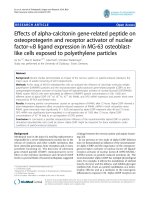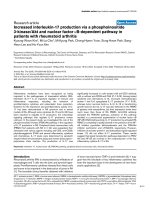Modulation of nuclear factor b signaling attenuates allergic airway inflammation 1
Bạn đang xem bản rút gọn của tài liệu. Xem và tải ngay bản đầy đủ của tài liệu tại đây (144.06 KB, 20 trang )
MODULATION OF NUCLEAR FACTOR-κB SIGNALING
ATTENUATES ALLERGIC AIRWAY INFLAMMATION
GOH YIQIAN FERA
(B.Sc, Hons.)
A THESIS SUBMITTED FOR
THE DEGREE OF DOCTOR OF PHILOSOPHY
DEPARTMENT OF PHARMACOLOGY
NATIONAL UNIVERSITY OF SINGAPORE
2012
Declaration
I hereby declare that this thesis is my original work and it has been written by me in its entirety. I
have duly acknowledged all the sources of information which have been used in the thesis.
This thesis has also not been submitted for any degree in any university previously.
Goh Yiqian Fera
18 October 2012
I
Acknowledgement
I would like to express my gratitude to Professor Fred Wong Wai-Shiu for his kind supervision
and guidance in my research work. I am grateful for his ideas, thoughts, experience, suggestions
and discussion time that have made our work possible
I am appreciative of Dr. Cheng Chang for sharing her valuable research experience with me,
teaching me numerous research techniques, and helping me with my research on bioactive
flavonol; Dr. Winston Liao Wu Peng for teaching me transfection techniques; Guan Shou Ping
for teaching me animal work techniques; Eugene Ho and Peh Hong Yong, for sharing with me
their research experience and providing me with useful ideas; Tao Lin, for coming over the
weekends to help me with my mouse asthma model; Alan Koh, for helping me with microscopy
work; Lah Lin Chin, for helping me and providing useful comments for my project; as well as
Genevieve Seow, Jonathan Lim, Khaing, Loh Xinyi, and Zhang Xueyu for their help and constant
encouragement.
I would like specially thank Nadine Upton Erica Gill and Katrina Louisa Tsu Ping Cook,
exchange students from King’s College London. They stayed back late in the laboratory and
came back over the weekends to help me with my projects. They have provided invaluable
assistance to my projects. This project would not have been completed without their contributions.
My sincere appreciation goes to our collaborators Professor Christopher Thiemermann,
A/Professor Alonso Slyvie, Dr. Bernard Leung, Dr. Gautam Sethi, Dr. Li Rui, Dr. Muthu
Shanmugam, and Dr. Nimesh Patel for all the learning opportunities they have given me.
I wish to thank all professors and seniors from the department of Pharmacology, NUS, from
whom I have learnt a lot during my graduate studies.
II
Lastly, I would like to thank my friends and my family for their care and support. They are my
source of motivation to persevere and strive for excellence in my work.
III
Table of contents
Declaration
I
Acknowledgements
II
Table of contents
IV
Summary
VIII
List of tables
X
List of figures
XI
List of abbreviations
XIII
List of publications and conference abstract
XIX
1. Introduction
1
1.1 Asthma
1.1.1 Epidemiology of asthma and impetus to develop novel anti-
2
inflammatory agents
1.1.2 Pathophysiology / Development of asthma
6
1.1.2.1 Airway Epithelial cells
8
1.1.2.2 T cell
11
1.1.2.3 B cell IgE production and mast cell activation
25
1.1.2.4 Eosinophils
27
1.1.2.5 Mucus hypersecretion
30
1.1.2.6 Airway hyperresponsiveness (AHR)
39
1.1.3 Current treatments and future direction for asthma
1. 2 Nuclear Factor (NF)-κB signaling pathway
41
48
1.2.1 Introduction of NF-κB signaling pathway
48
1.2.2. Role of NF-κB pathway in allergic inflammation
55
1.3 Receptor interacting protein (Rip) -2 and NF-κB signaling pathway
57
1.4 Ribosomal protein (RP)S -3 and NF-κB signaling pathway in lung cell lines 62
1.5 Small interfering RNA (siRNA) mechanism
64
1.6 Pharmacology of fisetin
70
IV
1.7 The Animal model of asthma
71
2. Rationale and objectives
75
3. Materials and methods
78
3.1 Materials and reagents
79
3.2 siRNA preparation
3.2.1 ON-TARGETplus siRNA without in vivo processing
81
3.2.2 ON-TARGETplus siRNA with in vivo processing
81
3.3 siRNA transfection in vitro
81
3.4 Mouse asthma model and treatments
83
3.5 Collection of bronchoalveolar lavage fluid (BALF) from mice
85
3.6 Preparation of BALF for total and differential cell count
85
3.7 Histological examination
87
3.8 AHR measurement
90
3.9 Lymphocyte antigen recall experiment
93
3.10 Enzyme-linked immunosorbent assay (ELISA)
3.10.1 Cytokines and chemokine levels in BALF or
cell culture supernatant
93
3.10.2 Immunoglobulin (Ig) levels in serum
94
3.10.3 MUC5AC level in cell lysate
94
3.11 RNA harvest and mRNA expression quantification
3.11.1 Storage of lung samples
95
3.11.2 Preparation of lung samples for RNA harvest
95
3.11.3 Preparation of cell culture samples for RNA harvest
95
3.11.4 RNA harvest
96
3.11.5 Reverse transcription (RT)-polymerase chain reaction (PCR)
96
3.11.6 Realtime (RT)-PCR
96
3.11.7 Semi-quantitative PCR
96
3.12 Immunoblotting
97
V
3.12.1 Lung protein extraction
97
3.12.2 Tissue protein nuclear extraction
97
3.12.3 Cell line protein extraction
98
3.12.4 Immunoblot
98
3.13 NF-κB transactivation assay (TransAM)
98
3.14 NF-κB reporter gene assay
3.14.1 NF-κB luciferase gene reporter assay
99
3.14.2 NF-κB/Secreted alkaline phosphatase (SEAP)
reporter gene assay
100
3.15 Band intensity analysis
100
3.16 Statistical analysis
101
4. Rip-2 gene silencing attenuates allergic airway inflammation in mice
104
4.1 Results
4.1.1 In vitro characterization of Rip-2 siRNA
105
4.1.2 Rip-2 silencing in vivo
105
4.1.3 Rip-2 siRNA suppresses OVA-induced inflammatory cell
recruitment and mucus production
109
4.1.4 Rip-2 siRNA reduces OVA-induced BALF cytokines and
serum IgE
114
4.1.5 Rip-2 siRNA suppresses OVA-induced inflammatory gene
expression in lungs
114
4.1.6 Rip-2 siRNA reduces OVA-induced AHR
114
4.1.7 Rip-2 silencing disrupts NF-κB signaling pathway
116
4.2 Discussion
116
5. Anti-inflammatory effects of RPS3 siRNA in vitro
127
5.1 Results
5.1.1 RPS-3 gene silencing in vitro
128
5.1.2 Effects of RPS-3 siRNA on TNF-α-induced MUC5AC
production
128
5.1.3 Effects of RPS-3 siRNA on TNF-α-induced inflammatory
cytokines and mediators
132
VI
5.1.4 Effects of RPS-3 siRNA on NF-κB activity
5.2 Discussion
132
141
6. Fisetin, a bioactive flavonol, attenuates allergic airway inflammation in mice
145
6.1 Results
6.1.1 Fisetin suppresses OVA-induced inflammatory
cell recruitment in BALF
146
6.1.2 Fisetin reduces OVA-induced airway cell infiltration
nd mucus production
146
6.1.3 Fisetin abates cytokine levels in BALF and serum
Ig production
150
6.1.4 Fisetin prevents OVA-specific lymphocyte responses in viv o
154
6.1.5 Fisetin blocks OVA-induced inflammatory gene expression
154
6.1.6 Fisetin attenuates OVA-induced AHR in mice
158
6.1.7 Fisetin disrupts NF-κB DNA activity in vivo
158
6.1.8 Effects of fisetin on TNF-α-induced NF-κB activation in
NHBE cells
158
6.2 Discussion
159
7. Conclusion
167
8. References
170
9. Appendix
233
VII
Summary
Asthma is an inflammatory lung disorder that accounts for significant morbidity and mortality
worldwide. Corticosteroid remains the first-line of treatment of this disease. However, such treatment
is associated with side-effects and does not change the chronic cause of the disease. Therefore, there
is an unmet medical need to develop novel anti-inflammatory therapy. Studies have associated
pathogenesis of allergic airway inflammation with persistent nuclear factor (NF)-κB signaling
pathway activation. This association has made NF-κB, a master pro-inflammatory transcription factor,
an attractive therapeutic target for asthma. However, NF-κB is essential for both normal biological
functions and pathological conditions. Therefore, total inhibition of NF-κB may not be a safe
approach. Appropriate and specific negative-regulation of the aberrantly elevated NF-κB activity
pathway may be a novel anti-inflammatory strategy for allergic airway inflammation. The objectives
of my project were to investigate the potential anti-inflammatory action of molecules that can
interfere with NF-κB signaling pathway: (1) Rip-2 siRNA; (2) RPS-3 siRNA; and (3) bioactive
flavonol fisetin.
The potential anti-inflammatory effect of Rip-2 siRNA was examined in an ovalbumin (OVA)induced mouse asthma model. A potent and selective Rip-2 siRNA given intratracheally knocked
down Rip-2 expression in OVA-challenged lungs, and reduced OVA-induced increases in total and
eosinophil counts, and Th2 cytokines and eotaxin levels in bronchoalveolar lavage fluid. Rip-2
silencing blocked OVA-induced inflammatory cell infiltration and mucus hypersecretion as observed
in lung sections, and mRNA expression of adhesion molecules and inflammatory mediators in lung
tissues. Also, elevation of serum OVA-specific IgE level in mouse asthma model was markedly
suppressed by Rip-2 siRNA. Furthermore, Rip-2 siRNA-treated mice produced significantly less
airway hyperresponsiveness induced by methacholine. Mechanistically, Rip-2 siRNA was found to
enhance cytosolic level of IκB, and block p65 nuclear translocation and DNA binding activity in lung
tissues from OVA-challenged mice.
The potential anti-inflammatory effect of RPS-3 siRNA was examined using TNF-α-stimulated lung
cell lines. Transfection of RPS-3 siRNA in lung cell lines significantly knock-down RPS-3 expression.
VIII
The down-regulation of RPS-3 expression was accompanied by suppressed NF-κB activation. For the
first time, we observed that down-regulation of RPS-3 suppressed TNF-α-induced MUC5AC
expression and IL-8 production. None of these effects were reproducible by control siRNA.
Finally, the potential anti-inflammatory effect of fisetin was investigated in OVA-induced mouse
asthma model. Intravenous administration of fisetin dose-dependently inhibited OVA-induced
increases in total cell count, eosinophil count, and Th2 cytokine levels recovered in bronchoalveolar
lavage fluid. It attenuated OVA-induced lung tissue eosinophilia and airway mucus production,
mRNA expression of adhesion molecules, chitinase, and inflammatory mediators in lung tissues, and
airway hyperresponsiveness to methacholine. Fisetin blocked NF-κB subunit p65 nuclear
translocation and DNA-binding activity in the nuclear extracts from lung tissues of OVA-challenged
mice. In normal human bronchial epithelial cells, fisetin repressed TNF-α-induced NF-κB-dependent
reporter gene expression.
In this Ph.D. project, I have demonstrated that intervention of NF-κB signaling pathway is linked to
attenuation of inflammation. These results suggest that Rip-2 siRNA, RPS-3 siRNA, and fisetin may
have therapeutic potential for treatment of allergic airway inflammation.
IX
List of tables
Table
Title
Page
1.1
The economic burden of asthma
1.2
A comprehensive list of known down-stream targets of NF-κB
signaling pathway relevant to asthma
47
1.3
siRNA therapeutics in clinical trial
51
1.3
siRNA in animal studies
67
3.1
Sequences of siRNA
82
3.2
Primer sets for RT-PCR
5
103
X
List of figures
Figure
Title
Page
1.1
World map of the prevalence of clinical asthma
4
1.2
Inflammatory and immune cells involved in allergic airway
inflammation
8
1.3
T cells involved in the induction of allergic phenotype
13
1.4
Components of airway allergic inflammation
17
1.5
Inflammatory mediators derived from eosinophil
29
1.6
Impact of mucus hypersecretion on airway obstruction in asthma
32
1.7
Molecular control of goblet cell metaplasia in asthma
34
1.8
Signaling pathway involved in TNF-α-mediated mucin synthesis
37
1.9
Molecular mechanism involved in IL-1β -mediated mucin expression
38
1.10
Members of NF-κB family
52
1.11
Canonical and non-canonical pathway of NF-κB
54
1.12
The nuclear regulation of NF-κB
58
1.13
Domain organization of the Rip family
59
1.14
Network of the Rip family members in the multiple cellular signaling
pathway
61
1.15
NF-κB mechanism of action
63
1.16
Mechanism of siRNA silencing
66
1.17
The structure of fisetin
71
3.1
OVA aerosolization system
86
3.2
Types of inflammatory cells in mouse BALF
88
3.3
Invasive system
92
4.1
Sequence dependent inhibition of Rip-2 mRNA and protein expression
by S2 in mouse cell lines
106
4.2
Inhibition of Rip-2 protein expression and mRNA by S2 in mouse
lungs
107
4.3
Effects of S2 on OVA-induced inflammatory cell recruitment and
mucus hypersecretion
110
XI
4.4
Effects of S2 on OVA-induced BALF cytokine and chemokine levels
and serum Ig production.
113
4.5
Effects of S2 on inflammatory gene expression in allergic airway
inflammation
115
4.6
Effects of S2 on OVA-induced AHR
117
4.7
Effects of S2 on NF-κB activity
118
5.1
Inhibition of RPS-3 mRNA by RPS-3 siRNA in human cell line NCIH292 (lung mucoepidermoid carcinoma)
129
5.2
Inhibition of RPS-3 mRNA by RPS-3 siRNA in human cell line
BEAS-2B (lung epithelial cell line)
130
5.3
Effects of RPS-3 siRNA on MUC5AC expression in NCI-H292 cells
131
5.4
Effects of RPS-3 siRNA on IL-8 expression in NCI-H292 cells
133
5.5
Effects of RPS-3 siRNA on IL-8 expression in BEAS-2B cells
134
5.6
Effects of RPS-3 siRNA on IL-6 expression in NCI-H292 cells
135
5.7
Effects of RPS-3 siRNA on IL-6 expression in BEAS-2B cells
136
5.8
Effects of RPS-3 siRNA on TSLP expression
137
5.9
Effects of RPS-3 siRNA on p65 DNA-binding activity
138
5.10
Effects of RPS-3 siRNA on NF-κB activity in NF-κB/SEAPorter™
HEK293 cell line
140
6.1
Differential cell counts in BALF
147
6.2
Effects of fisetin on BALF cell infiltration
148
6.3
Effect of fisetin on PBMC
149
6.4
Histological examination of lung tissue
151
6.5
Effects of fisetin on OVA-induced BALF cytokine and chemokine
levels
152
6.6
Effects of fisetin on OVA-induced serum Ig production
153
6.7
Effects of fisetin on OVA-specific responses in vivo
155
6.8
Effects of fisetin on pulmonary mRNA expression of inflammatory
genes
157
6.9
Effects of fisetin on OVA-induced AHR
160
6.10
Effects of fisetin on OVA-induced NF-κB activity in vivo
161
XII
List of abbreviations
Ad12SV40
Adenovirus 12-simian virus 40 hybrid virus
AHR
Airway hyperresponsiveness
Al(OH)3
Aluminium hydroxide
AMCase
Acidic mammalian chitinase
AMD
Age related macular degeneration
AMV
Avian mammalian chitinase
ANK
Ankyrin repeats
AP
Alkaline phosphatase
AP-1
Activating protein-1
APC
Antigen presenting cell
ASM
Airway smooth muscle
ASO
Antisense oligonucleotide
ATP
Adenosine Triphosphate
BALF
Bronchoalveolar lavage fluid
BCA
Bicinchonic acid
BLT1
Leukotriene B4 receptor 1
BSA
Bovine serum albumin
Cdyn
Dynamic compliance
c/EBP
CCAAT/enhancer binding protein
cAMP
Cyclic adenosine monophosphate
CARD
Caspase activation and recruitment domain
CBP
cAMP response element-binding protein (CREB) binding protein
CCL
Chemokine ligand
CCR
Chemokine receptor
CD
Cluster of differentiation
XIII
CD40L
Cluster of differentiation 40 ligand
CFTR
Cystic fibrosis transmembrane conductance regulator
CRTH2
Chemoattractant homologous receptor expressed on Th2 cells
CTLA
Cytotoxic T-lymphocyte antigen
CXCR
Chemokine (C-X-C motif) receptor
CysLT
Cysteinyl leukotrienes
CysLT1R
Cysteinyl leukotriene 1 receptor
CysLT2R
Cysteinyl leukotriene 2 receptor
DAMP
Danger-associated molecular pattern
DMSO
Dimethyl sulfoxide
DNA
Deoxyribonucleotide
DOTAP
1,2-Dioleoyl-3-trimethylammonium-propane
ECM
Extracellular matrix
ECP
Eosinophil cationic Protein
EDN
Eosinophil-derived neurotoxin
EGF
Epidermal growth factor
EGFR
Epidermal growth factor receptor
EMSA
Electrophoretic mobility shift essay
Eos
Eosinophil
EP2
Prostaglandin E2 receptor
EPO
Eosinophil peroxidase
ER
Endoplasmic reticulum
ERK
Extracellular signal regulated kinase
FBS
Fetal bovine serum
FCS
Fetal calf serum
FcεRI
High affinity IgE receptor
XIV
FcεRII
Low affinity IgE receptor
FEV1
Forced expiratory volume in 1 second
FOXP3
Forkhead box P3
H&E
Hematoxylin and Eosin
GATA
trans-acting T cell-specific transcription factor
GM-CSF
Granulocyte-macrophage colony-stimulating factor
hCLCA1
human calcium-activated chloride channel
hnRNP K
Heterogeneous nuclear protein K
ICAM-1
Intercellular adhesion molecule-1
ICOS
Inducible costimulatory molecules
IFN
Interferon
Ig
Immunoglobulin
IKK
Inhibitor of NF-κB kinase
IL
Interleukin
IL-4R
IL-4 receptor
IN
Intranasal
iNOS
Inducible nitric oxide synthase
IP
Intraperitoneal
IRE
Inositol-requiring enzyme
IT
Intratracheal
IV
Intravenous
IκB
Inhibitor of NF-Κb
JAK
Janus kinase
KD
Kinase domain
LABA
Long acting β2 agonist
LPA
Lysophophatidic acid
XV
LPS
Lipoploysaccharide
LRR
Leucine-rich repeat
LTB4 receptor Leukotriene B4 receptor 1
LTA
Lipoteichoic acid
LTRA
Leukotriene receptor antagonist
Lym
Lymphocyte
Mac
Macrophage
MAPK
Mitogen-activated protein kinases
MARCKS
Myristoylated alanine-rich C-kinase substrate
MBP
Major basic protein
MCP
Monoctye chemotatic protein
MEKK
Mitogen-activated protein/extracellular signal-regulated kinase kinase
MHC
Major histocompatitbility complex
MSK
Mitogen and stress activating kinases
Myd
Myeloid differentiation primary response gene
NEMO
NF-κB essential modulator
Neu
Neutrophil
NFAT
Nuclear factor activated T cell
NF-κB
Nuclear factor-κB
NHBE
Normal human bronchial epithelial
NH4Cl
Ammonium chloride
NKT
Natural killer cell
NOD
Nucleotide oligomerisation domain
NLRP
NOD-like receptor protein
NPRA
Natriuretic peptide receptor A
OVA
Ovalbumin
XVI
PAF
Platelet activating factor
PAMP
Pathogen associated molecular patterns
PBS
Phosphate buffered saline
PBMC
Peripheral blood mononuclear cell
PCR
Polymerase chain reaction
PDE
Phosphodiesterase
PG
Prostaglandin
PKA
Protein Kinase A
PKAc
Protein Kinase A catalytic subunit
PLA2
Phospholipase A2
PRR
Pattern recognition receptors
RANKL
Receptor activator NF-κB ligand
RANTES
Regulated and normal T cell expressed and secreted
Rel
v-rel reticuloendotheliosis viral oncogene homolog
RHD
Rel homology domain
RHIM
Rip homolytic interaction domain
Rip
Receptor interacting protein
RISC
RNA-induced silencing complex
Rl
Lung resistance
RNA
Ribonucleic acid
RNAi
RNA interference
Roc/COR
Ros of complex proteins/C-terminal of Roc
ROR
Orphan retinoic acid nuclear receptor
ROS
Reactive Oxygen Species
SCF
Stem cell factor
SDS
Sodium dodecyl sulfate
XVII
SiRNA
Small interfering RNA
SIT
Specific immunotherapy
SLPI
Secretory Leukocyte Protease Inhibitor
SNALPs
Stable nucleic acid-lipid particules
SPDEF
SAM pointed domain-containing Ets transcription factor
SphK
Sphingosine kinase
STAT
Signal transducer and activator of transcription
TAE
Tris-acetate-Ethylenediaminetetraacetic acid (EDTA)
TAK
TGF-β activated kinase
TAS2R
Agonists of bitter taste receptors
TCR
T cell receptor
TEMED
Tetramethylethylenediamine
TGF-β
Transforming growth factor β
TH
T-helper
TLR
Toll-like receptor
TMB
Tetramethylbenzidine
TNF
Tumor necrosis factor
Treg
T-regulatory cells
TSLP
Thymic stromal lymphopoietin protein
UPR
Unfolded protein response
UV
Ultraviolet
VCAM-1
Vascular cell adhesion molecule-1
VEGF
Vascular endothelial growth factor
VLA
Very late antigen
XBP
X box-binding protein
XVIII
List of Publications and conference abstracts
Publications
Liao W, Goh FY, Betts RJ, Kemeny DM, Tam J, Bay BH, Wong WS. 2011. A novel anti-apoptotic
role for apolipoprotein L2 in IFN-γ-induced cytotoxicity in human bronchial epithelial cells .J. Cell.
Physiol. Feb; 226(2):397-406.
Cheng C, Ho WE, Goh FY, Guan SP, Kong LR, Lai WQ, Leung BP, Wong WS. 2011 Anti-malarial
drug artesunate attenuates experimental allergic asthma via inhibition of the phosphoinositide 3kinase/Akt pathway. PloS One. 6(6):e20932. Epub 2011 Jun 9
Patel NS, Nandra KK, Brines M, Collino M, Wong WF, Kapoor A, Benetti E, Goh FY, Fantozzi R,
Cerami A, Thiemermann C. 2011. A nonerythropoietic peptide that mimics the 3D structure of
erythropoietin reduces organ injury/dysfunction and inflammation in experimental hemorrhagic shock.
Mol. Med. Sep-Oct;17(9-10):883-92.
Goh FY, Upton N, Guan S, Cheng C, Shanmugam MK, Sethi G, Leung BP, Wong WS. 2012. Fisetin,
a bioactive flavonol, attenuates allergic airway inflammation through negative regulation of NF-κB.
Eur. J. Pharmacol. Mar 15;679(1-3):109-16. Epub 2012 Jan 20.
Nandra KK, Takahashi K, Collino M, Benetti E, Wong WS, Goh FY, Suzuki K, Patel NS,
Thiemermann C.2012. Acute treatment with bone marrow-derived mononuclear cells attenuates the
organ injury/dysfunction induced by hemorrhagic shock in the rat. Shock. Jun;37(6):592-8.
Li R, Cheng C, Chong SZ, Lim AR, Goh YF, Locht C, Kemeny DM, Angeli V, Wong WS, Alonso S.
2012 Attenuated Bordetella pertussis BPZE1 protects against allergic airway inflammation and
contact dermatitis in mouse models. Allergy. Oct;67(10):1250-8.
Goh FY, Cook K, Upton N, Tao L, Lah LC, Wong WS. Rip-2 Gene silencing attenuates allergic
airway inflammation. J. Immuno. Revision, 2012
Conference abstracts
Cold Spring Harbor Asia Conferences: Frontiers of Immunology in Health and Diseases
Suzhou, China (September 3rd - 7th 2012)
Rip-2 silencing attenuates allergic airway inflammation in mice.
Goh FY, Cook KTP, Upton N, Tao L, Lah LC and Wong WSF.
Presented by Professor Fred Wong Wai-Shiu
7th Annual RNAi Conference 2012: Gene Regulation by Small RNAs.
Oxford, United Kingdom (March 27th - 29th 2012)
Rip-2 silencing attenuates allergic airway inflammation in mice.
Goh FY, Cook KTP, Upton N, Tao L, Lah LC and Wong WSF.
Poster presented by Goh Yiqian Fera
XIX


